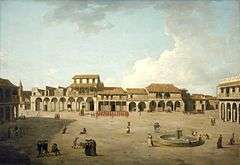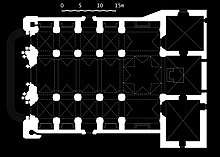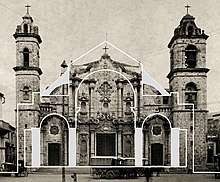Havana Cathedral
| Catedral de San Cristobal | |
|---|---|
.jpg) Catedral of Havana | |
| Basic information | |
| Location | Havana, Cuba |
| Geographic coordinates | 23°08′29″N 82°21′07″W / 23.1414°N 82.3519°WCoordinates: 23°08′29″N 82°21′07″W / 23.1414°N 82.3519°W |
| Affiliation | Roman Catholic |
| District | Archdiocese of San Cristóbal de la Habana |
| Ecclesiastical or organizational status | Cathedral |
| Architectural description | |
| Architectural type | Church |
| Architectural style | Baroque |
| Completed | 1777 |
| Specifications | |
| Direction of façade | South-east |
| Length | 49m |
| Width | 30m |
| Width (nave) | 10m |
| Materials | Coral stone |
Havana Cathedral (Catedral de San Cristobal) is one of eleven Catholic cathedrals on the island. It is located in the Plaza de la Catedral on Calle Empedrado, between San Ignacio y Mercaderes, Habana Vieja. The thirty by forty nine meter rectangular church serves as the seat of the Roman Catholic Archdiocese of San Cristobal de la Habana.[1] Christopher Columbus’ remains were kept in the cathedral between 1796 and 1898, before they were taken to Seville Cathedral.[2]
History
The largest missionary group were priests of the Society of Jesus. After extensive petitioning and the purchase of a piece of land in the Plaza by Diego Evelino Hurtado de Compostela, Bishop of Santiago de Cuba, a permit was granted. The cathedral is set in the former Plaza de La Ciénaga. In 1727 plans to build a church, convent and collegium were approved and the project began to take form. The plaza is located on the site of a swamp that was drained and used as a naval dockyard before the cathedral was built.

The Jesuits began construction of the cathedral in 1748 on the site of an earlier church and it was completed in 1777, well after King Carlos III expelled the Jesuits from the island in 1767. The cathedral once held remains of Christopher Columbus
In 1796, after the Peace of Basel was signed and Spain ceded most of Hispaniola to France, the remains of Columbus were moved and laid to rest in the cathedral's Altar of the Gospel. The gravestone read "Oh Remains and Image of Great Columbus, Be Preserved One Thousand Years in the Funerary Urn." The remains were returned to Spain in 1898 after the Cuban War of Independence.[3]
Architecture


The Cathedral's front elevation is Baroque with asymmetrical bell towers. The detail are similar to those of the San Carlos and San Ambrosio Seminary which is part of the same complex. One can see fossilized marine fauna and flora in the stone walls as the Cathedral is, as many buildings in Havana are, constructed out of blocks of coral.[2][4] The cathedral was renovated between 1946 and 1949 in the neoclassical style. Cuban architect Cristobal Martinez Marquez headed the project and through a series of architectural procedures gave the church interior a more open and grandiose space, allowed more light to enter, and improved its ventilation system. The cathedral's interior is stone with a white and black marble floor. It has a central nave, two side aisles and eight side chapels. The central arches of the nave are buttressed by eight stone flying arches located above the side aisles on the exterior of the cathedral as can be seen on the section. The flying arches, the dome over the transept or the orange roof tiles cannot be seen from the square. The width of the central nave is fifteen meters. The plan forms a Latin cross.
Artworks
The cathedral contains a number of paintings and frescoes. There are copies of paintings in the side chapels by Rubens and Murillo on the altars. There is a sculpture of Saint Christopher, Patron Saint of Havana, which dates from 1632 and was made by Martín de Andújar Cantos in Seville, Spain. Above the altar are three fading frescoes by Italian artist Giuseppe Perovani, a neoclassical artist who was commissioned by Bishop Juan José Díaz de Espada y Fernánez de Landa of the Roman Catholic Archdiocese of San Cristóbal de la Habana to paint three scenes: The Delivery of the Keys, The Last Supper and The Ascension. The cathedral stands within the area of Old Havana that UNESCO designated a World Heritage Site in 1982.[5]
Photo gallery
References
- ↑ Archdiocese of Havana
- 1 2 "Havana Cathedral". Retrieved 2018-10-04.
- ↑ "The Havana Cathedral; History of Main Parish". Archived from the original on 2014-03-24. Retrieved 2014-03-24.
- ↑ "Coral As A Building Material" (PDF). Retrieved 2018-10-06.
- ↑ "UNESCO".
External links
| Wikimedia Commons has media related to Catedral de Havana. |

.jpg)
.jpg)

